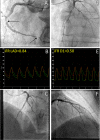Instantaneous wave-free ratio guided multivessel revascularisation during percutaneous coronary intervention for acute myocardial infarction: study protocol of the randomised controlled iMODERN trial
- PMID: 33452200
- PMCID: PMC7813313
- DOI: 10.1136/bmjopen-2020-044035
Instantaneous wave-free ratio guided multivessel revascularisation during percutaneous coronary intervention for acute myocardial infarction: study protocol of the randomised controlled iMODERN trial
Abstract
Introduction: Recent randomised clinical trials showed benefit of non-culprit lesion revascularisation in ST-elevation myocardial infarction (STEMI) patients. However, it remains unclear whether revascularisation should be performed at the index procedure or at a later stage.
Methods and analysis: The instantaneous wave-free ratio (iFR) Guided Multivessel Revascularisation During Percutaneous Coronary Intervention for Acute Myocardial Infarction trial is a multicentre, randomised controlled prospective open-label trial with blinded evaluation of endpoints. After successful primary percutaneous coronary intervention (PCI), eligible STEMI patients with residual non-culprit lesions are randomised, to instantaneous wave-free ratio guided treatment of non-culprit lesions during the index procedure versus deferred cardiac MR-guided management within 4 days to 6 weeks. The primary endpoint of the study is the combined occurrence of all-cause death, recurrent myocardial infarction and hospitalisation for heart failure at 12 months follow-up. Clinical follow-up includes questionnaires at 3 months and outpatient visits at 6 months and 12 months after primary PCI. Furthermore, a cost-effectiveness analysis will be performed.
Ethics and dissemination: Permission to conduct this trial has been granted by the Medical Ethical Committee of the Amsterdam University Medical Centres (loc. VUmc, ID NL60107.029.16). The primary results of this trial will be shared in a main article and subgroup analyses or spin-off studies will be shared in secondary papers.
Trial registration number: NCT03298659.
Keywords: coronary heart disease; coronary intervention; ischaemic heart disease; magnetic resonance imaging; myocardial infarction.
© Author(s) (or their employer(s)) 2021. Re-use permitted under CC BY-NC. No commercial re-use. See rights and permissions. Published by BMJ.
Conflict of interest statement
Competing interests: None declared.
Figures



Similar articles
-
Complete revascularisation versus treatment of the culprit lesion only in patients with ST-segment elevation myocardial infarction and multivessel disease (DANAMI-3—PRIMULTI): an open-label, randomised controlled trial.Lancet. 2015 Aug 15;386(9994):665-71. doi: 10.1016/s0140-6736(15)60648-1. Lancet. 2015. PMID: 26347918 Clinical Trial.
-
Instantaneous wave-free ratio-guided revascularization of non-culprit lesion in patients with ST-segment elevation myocardial infarction and multivessel coronary disease: design and rationale of the WAVE Registry.Minerva Cardiol Angiol. 2021 Jun;69(3):291-298. doi: 10.23736/S2724-5683.20.05229-9. Epub 2021 Jan 11. Minerva Cardiol Angiol. 2021. PMID: 33427419
-
Immediate versus staged complete revascularisation in patients presenting with acute coronary syndrome and multivessel coronary disease (BIOVASC): a prospective, open-label, non-inferiority, randomised trial.Lancet. 2023 Apr 8;401(10383):1172-1182. doi: 10.1016/S0140-6736(23)00351-3. Epub 2023 Mar 5. Lancet. 2023. PMID: 36889333 Clinical Trial.
-
Target-vessel versus multivessel revascularisation in ST-elevation myocardial infarction: a meta-analysis of randomised trials.Heart Lung Circ. 2015 Apr;24(4):327-34. doi: 10.1016/j.hlc.2014.10.013. Epub 2014 Dec 5. Heart Lung Circ. 2015. PMID: 25547531 Review.
-
Meta-Analysis of Randomized Controlled Trials Comparing Multivessel Versus Culprit-Only Revascularization for Patients With ST-Segment Elevation Myocardial Infarction and Multivessel Disease Undergoing Primary Percutaneous Coronary Intervention.Am J Cardiol. 2015 Jun 1;115(11):1481-6. doi: 10.1016/j.amjcard.2015.02.046. Epub 2015 Mar 12. Am J Cardiol. 2015. PMID: 25840579 Review.
Cited by
-
2023 European Society of Cardiology guidelines for the management of acute coronary syndromes : Statement of endorsement by the NVVC.Neth Heart J. 2024 Oct;32(10):338-345. doi: 10.1007/s12471-024-01896-2. Epub 2024 Sep 10. Neth Heart J. 2024. PMID: 39254829 Free PMC article. Review.
-
Myocardial perfusion imaging in advanced coronary artery disease.Eur J Clin Invest. 2025 Jul;55(7):e70024. doi: 10.1111/eci.70024. Epub 2025 Mar 18. Eur J Clin Invest. 2025. PMID: 40099580 Free PMC article. Review.
-
Quantitative Flow Ratio to Predict Non-Target-Vessel Events Before Planned Staged Percutaneous Coronary Intervention in Patients With Acute Coronary Syndrome.J Am Heart Assoc. 2024 Jan 2;13(1):e031847. doi: 10.1161/JAHA.123.031847. Epub 2023 Dec 29. J Am Heart Assoc. 2024. PMID: 38156592 Free PMC article.
-
Complete revascularization in acute myocardial infarction: a clinical review.Cardiovasc Interv Ther. 2023 Apr;38(2):177-186. doi: 10.1007/s12928-022-00907-6. Epub 2023 Jan 7. Cardiovasc Interv Ther. 2023. PMID: 36609898 Free PMC article. Review.
References
-
- Ibanez B, James S, Agewall S, et al. . 2017 ESC guidelines for the management of acute myocardial infarction in patients presenting with ST-segment elevation: the task force for the management of acute myocardial infarction in patients presenting with ST-segment elevation of the European Society of cardiology (ESC). Eur Heart J 2018;39:119–77. 10.1093/eurheartj/ehx393 - DOI - PubMed
Publication types
MeSH terms
Associated data
LinkOut - more resources
Full Text Sources
Other Literature Sources
Medical
Miscellaneous
